 Last October I wrote up a list of my top ten games from Essen '05. In the six months since I've dutifully waited for those games to make their sometimes long, arduous trip from Europe, and have finally gotten to play all of them--or at least the nine that were actually released.
Last October I wrote up a list of my top ten games from Essen '05. In the six months since I've dutifully waited for those games to make their sometimes long, arduous trip from Europe, and have finally gotten to play all of them--or at least the nine that were actually released.This is the second part of my review of those games, talking about what I liked and what I didn't. In my first article in this series I covered the top five, a set of games that I thought were entirely worth playing. Here I'm going to cover a few more above average games, but also a few that I was in the end disappointed by.
#6: PUNCT (B)
My Thoughts: just this article
Authors: Kris Burm
Synopsis: connections
Background: abstract
U.S. Publisher: Rio Grande Games
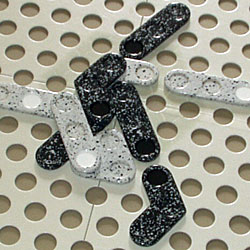 I'm generally not fond of abstracts & I don't own any of the other GIPF games. I played the original GIPF online, and wasn't impressed by the simplistic gameplay, and that was generally that. However, PUNCT interested me for two reasons. First, because I'd called it out here, I wanted to be able to follow-up on all of the games I mentioned from last year's Essen, not all-of-them-except-PUNCT. Second, it did interest me because of fond memories of Twixt. So when I saw an opportunity to get PUNCT as part of a trade earlier this year, I did. Nonetheless, I went into my first play of PUNCT not expecting a lot. I was surprised.
I'm generally not fond of abstracts & I don't own any of the other GIPF games. I played the original GIPF online, and wasn't impressed by the simplistic gameplay, and that was generally that. However, PUNCT interested me for two reasons. First, because I'd called it out here, I wanted to be able to follow-up on all of the games I mentioned from last year's Essen, not all-of-them-except-PUNCT. Second, it did interest me because of fond memories of Twixt. So when I saw an opportunity to get PUNCT as part of a trade earlier this year, I did. Nonetheless, I went into my first play of PUNCT not expecting a lot. I was surprised.The basic idea of the game is connection building--creating links from one half of the board to another. It's a theme which has been seen in Twixt, Knots, Metro, and many others. However, the connectivity of this game is really made by two facts. First, you can not only move pieces after they're played, but you can in fact move pieces atop each other, changing PUNCT into a three-dimensional game reminescent of Java or Torres. Second, there's lots of interesting and clever tactics possible, along with bluffing and obfuscation, all in a very simple package.
There are some downsides too. The board feels flimsy and nothing stacks quite as simply as I'd like. I've seen new players get confused by adjacencies in a few different ways. And, some of the late gameplay can be really methodical, with strike and counterstrike centering on who makes the first mistake as much as who makes the more clever play.
Nonetheless, it's a fun game, and one of the best abstracts I've played in years (alongside Rumis and a few others). Sadly, my wife doesn't like it, but I keep sticking it into game bags hoping that a two-player play opportunity opens up.
#7: Hacienda (B)
My Thoughts: Mini-Review & Strategy Notes (1/06)
Authors: Wolfgang Kramer & Michael Kiesling
Synopsis: economics, connections, card management
Background: Argentica, early 19th century
U.S. Publisher: Rio Grande Games
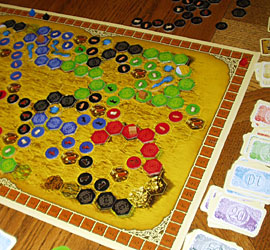 Hacienda is a game that flared up very quickly for me, briefly enjoyed the status of "best. game. evar." and then dropped back down to an above-average rating.
Hacienda is a game that flared up very quickly for me, briefly enjoyed the status of "best. game. evar." and then dropped back down to an above-average rating.On its face Hacienda is a somewhat complex card-collection & connection game. You're laying out a series of lands, animal herds, water, and hacienda to advance your position in the game. Lands, water, and hacienda are worth victory points, but animals are necessary for you to earn money needed to buy these resources. It's ultimately a delicate balance. There's so much richness there that it can be overwhelming at first, and that's what made me initially rank it higher.
Hacienda's problem, I think, is that it wasn't distributed in its optimal gamer's game form. Out of the box creating chains of land is very powerful and its very hard to block. This is what started to sour me on the game by my second time out, because all of those great, crunchy strategies devolved down into one push for victory.
Hacienda does give you some alternatives. There's two maps (one on either side of the board, a great innovation that more publishers should take note of) and the asymmetrical map makes it a tiny bit harder to create huge chains of land due to the breaks in terrain. Meanwhile I've been told that the alternate rules provided in the game increase the value of animals. I've been using the asymmetrical board the last few times I've played, but I haven't quite girded myself to learn an entirely different method of scoring not marked on the quick-ref sheets. If Hacienda had been distributed with a different default board and a different default ruleset I might have a slightly better impression, but honestly, it is first (or second) impressions that count.
Don't get me wrong. Hacienda is a fine game. In fact, it feels somewhat like the award-winning Ticket to Ride--in feel if not gameplay. There's semi-open card drafting, and there's brinkmanship as you push ahead of your opponents. Perhaps I just wanted a little more ...
#8: Mesopotamia (B-)
My Thoughts: Review (1/06)
Authors: Klaus-Jurgen Wrede
Synopsis: civilization building & resource management
Background: Mesopotamia, The Ancient World
U.S. Publisher: Mayfair Games
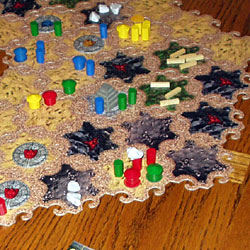 Although Mesopotamia isn't my worst rated of the exciting Essen games, it is the one which I expected the most of, but didn't deliver. From the start the production of Mesopotamia was clearly entirely beautiful. And, Klaus-Jurgen Wrede has a good rep with me. Carcassonne is great, I quite enjoy Der Untergang von Pompeji, and even though I didn't like his Die Fugger I thought it was an interesting design. My interest level in Mesopotamia just went up when I read the rules and discovered it was a very tactical game.
Although Mesopotamia isn't my worst rated of the exciting Essen games, it is the one which I expected the most of, but didn't deliver. From the start the production of Mesopotamia was clearly entirely beautiful. And, Klaus-Jurgen Wrede has a good rep with me. Carcassonne is great, I quite enjoy Der Untergang von Pompeji, and even though I didn't like his Die Fugger I thought it was an interesting design. My interest level in Mesopotamia just went up when I read the rules and discovered it was a very tactical game.And then I played it and found it boring. And played it again and found it repetitive. When I reviewed Mesopotamia the best explanation I could give was that it "doesn't spark". However I think Tom Vasel hit it more dead-on when he said that the strategy is very much the same from game-to-game.
At heart Mesopotamia is a very logistical resource-management game. Everything in the genre is, to some degree or another, about producing your resources faster than everyone else, but the collection and conversion of resources are so explicitly a path toward victory in this game, that it's that much obvious that every misstep is a step away from victory, and that sucks a lot of the life out of the game for me.
Again, not a bad game, but not even as good as the aforementioned Hacienda. I rate it solely average on the actual gameplay, and I have a lot of above-average games to play instead. This is the first of the Essen games that I don't expect to keep in my collection because I doubt I'll play it again unless someone else is really enthusiastic.
#9: Antike (C+)
My Thoughts: First Thoughts (1/06), Mini-Review (2/06)
Authors: Mac Gerdts
Synopsis: civilization building, resource management & warfare
Background: Europe, The Ancient World
U.S. Publisher: None
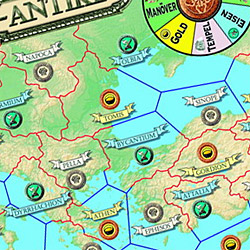 This game was actually not on my original Essen list, but I've since added it to replace the no-show, Tempus. Though I, in the end, wasn't too happy with the design, I think it was a fine entrant for "interesting games released at Essen".
This game was actually not on my original Essen list, but I've since added it to replace the no-show, Tempus. Though I, in the end, wasn't too happy with the design, I think it was a fine entrant for "interesting games released at Essen".This game looks like a short wargame with technology and civilization building in and about Europe; in other words, Civilization Light, a Holy Grail for game designers, and a term which recently has been applied to many releases. Parthenon was another game that didn't actually match this hype last year, and the jury is still out on the aforementioned Tempus, another contender. However, one of the game's largest problems turns out to be a serious impression-to-gameplay disconnect.
In truth Antike isn't Civilization Light at all. Instead, it'ss a pretty serious logistics game, all about making the most efficient use of resources faster than your opponents, in some ways like the recently discussed Mesopotamia. So, call it St. Petersburg Heavy.
To be honest, I don't like logistical games that much, and I was further put off by Antike looking like a totally different type of game. However beyond that I also think Antike is an indie game in real need of outside development. The combat system doesn't quite work, and the victory system can potentially drive the game to a grinding halt if you're not lucky.
There's a lot of interesting ideas in the game, primary among them the original, circular role-selection system. This is a "roundel" which your pawn slowly circles. You get a special role action depended on where you land, but in order to move extra spaces around the roundel takes resources. Thus, you have to trade off between subpar matching of roles with no resource loss, or else take advantage of complementary roles, but only by getting rid of resources that you could have used elsewhere. The idea of paying resources to take roles does go back to at least Puerto Rico, where a somewhat similar mechanism is created by putting gold coins on unused roles, but here it's unadulterated (though as we'll see another game from this year, Siena, uses a similar mechanism).
The limited, card-based VPs are neat too, in idea if not execution.
However the overall resulting gameplay is average at best, and not something I'm very interested in repeating after a few times out.
Recent word indicates this game might soon be available from Rio Grande.
#10: Siena (C-)
My Thoughts: Review (4/06)
Authors: Mario Papini
Synopsis: card management & logistics
Background: Siena, 1338
U.S. Publisher: Z-Man Games
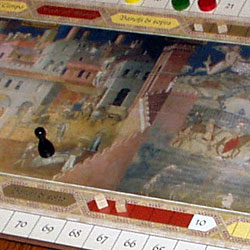 Siena was the last game I played of my Essen 10, and sadly, also the most disappointing. In my original article I said "The big idea here simply seems to be beautiful art: the background of the board is a classic mosaic." Beyond that the game is a somewhat interesting logistical game of purchasing cards through a draft, then using those cards to gain money and/or victory points. However, it's the painting that's really the center of the game, and that turns out to be a huge problem.
Siena was the last game I played of my Essen 10, and sadly, also the most disappointing. In my original article I said "The big idea here simply seems to be beautiful art: the background of the board is a classic mosaic." Beyond that the game is a somewhat interesting logistical game of purchasing cards through a draft, then using those cards to gain money and/or victory points. However, it's the painting that's really the center of the game, and that turns out to be a huge problem.Clearly the game designer wanted to show the painting in its original form, and as a result the cards which reprint parts of the painting and the game board which is the painting have almost no player-usable information. You have to remember what cards do and what board locations do with very little help. Besides that, the rulebook is a trainwreck, badly translated, badly organized, and full of special cases. Almost any player is going to be put off the game before it ever hits the table.
Besides the fair logistics the game has three interesting points. First, you can quickly vary your money up and down and since it influences turn order and other issues, this can be a serious and meaningful tactical point. Second, players advance through three roles during the game (peasant/merchant/banker) and through two distinct phases of play, and the ways in which players of different levels interact is quite clever. Third, the final, banker phase, involves players circling around a 10-space city to undertake certain actions. They can also expend resources to circle more quickly, resulting in a game system that's extremely similar to the just-mentioned roundel in Antike; they're both the same, entirely innovative and unique, form of role-selection. Siena just has a geographical theming.
Siena also has one flaw in the gameplay: it's way too long, especially when people get to the banker phase and things get really dull. At 2-4 hours long, Siena at least doubly outlasts its stay with me. I can believe really serious logistical players might like it fine, because there is stuff to like, but given the terrible utility design of the components, most people aren't going to be willing to give this game the time of day.
Like Mesopotamia and Antike, I thought Siena had average gameplay with some high points and some low points. My main difference in rating these three games came down to components. Mesopotamia and Antike were both pretty easy to use, but the first was entirely beautiful and the second was just nice. Contrariwise Siena was one of those games that, while the components were pretty enough, they actively made it much more difficult to play the game.
Having finished my own rating of my Essen 2005 games, I thought it'd be interesting to compare my own ratings to those at BGG. The BGG ratings are not bayesian filtered, but the standings are.
| Game | Me | BGG |
| Caylus | A | 8.45 (#2) |
| Reef Encounter | A | 7.80 (#37) |
| Il Principe | B+ | 7.01 (#400) |
| Elasund | B+ | 7.10 (#244) |
| Railroad Tycoon | B+ | 7.93 (#23) |
| PUNCT | B | 7.59 (#155) |
| Hacienda | B | 7.41 (#131) |
| Mesopotamia | B- | 6.97(#353) |
| Antike | C+ | 7.58 (#102) |
| Siena | C- | 6.94 (#543) |
I apparently don't entirely march to the beat of the common drummer. From those standings I think that Il Principe and Elasund are both dramatically underappreciated and Antike overly so.
It's already been a couple of months since my Nurnberg 2006 list. (Ah, where does the time go?) Those games are trickling out much more slowly than the Essen games, which isn't a surprise since Nurnberg tends to show off more prototypes rather than just finished games.
I've played one of my ten games thus far, Ticket to Ride Marklin (A). I've played so much Ticket to Ride at this point that I'm not as enthused by a new edition, but it's clearly an excellent game, better balanced and more strategic than Europe, which was in turn better and more balanced than the original. That's the right direction to be heading in! I've also played Double or Nothing (C+), which would have been around #13 if I'd included more than 10 Nurnberg games. It was a pretty average press-your-luck game. Better designed than most, no surprise, but also a little less exciting.
Meanwhile, word out of the Gathering of Friends highlighted another couple of the games I mentioned. Most folks agreed that Augsburg 1520 and Thurn & Taxis were among the most played & beloved games. Meanwhile Cleopatra seems to have gotten much more of an average reception, which perhaps isn't a surprise, as no one ever said it was a gamer's game.
Colovini's Masons is the one game that I didn't mention that seems to have gotten some good positive attention. Colovini has been so hit-or-miss lately that the game's cool looking theme and beautiful pieces just didn't do it for me, but if I'd been making a post-Gathering list rather than post-Nurnberg one, it would have been in my top 10 (perhaps knocking Gloria Mundi off, based on the fact thatI'm not convinced it'll see print this Summer).
Meanwhile, two of the most-hated games out of the Gathering seem to be For Rum, Renown & Honor and Celtica. They got pulled from my top ten list for "the crime of being a family game", but they were still in my top 15. It looks like my decision to pull them was right!
I expect I'll follow up here with a list of my full after-thoughts on my Nurnberg 10, but it'll probably be this summer, as I still have 9 more to play!
Next week it's back to Carcassonne with my final look at the Carcassonne expansions, and some really fancy charts.
4 comments:
Your opinions are valid...
GIPF is deeper than the first impression leaves, just like Go is much deeper than the simplistic rules would seem. PUNCT I like less than the rest of the GIPF series, but I think that's mostly because I don't understand connection games (I'm not that great at Hex).
Hacienda with the advanced rules is far better for gamers than the basic rules. The basic rules are nice for learning, and probably best for people looking for a lighter game, but Kramer's variants turn the game for the better (and it's still not that heavy).
I have never played a "real" Civilization game, so wasn't disappointed by Antike, nor was I unhappy with how Antike looked. There are plenty of games with maps that don't look like the Civ game maps I've seen, but perhaps the structure is more the same that I realize. Combat costs you a lot, which definitely changes the texture of the game compared to other war games; it's not broken.
I played Tempus, and Antike scratches much of the same itch, although I liked some of what Tempus did better (the special cards, even if they were very controlled, did make a huge difference; as did the modular board, but I have always liked modular boards). Combat in Tempus is pretty rough as well, so I don't mind what's there in Antike.
I haven't played Mesopotamia.
I have played Siena. To tell the truth, the first game was the one that made a really bad impression on me, and while I'm quite willing to go back to games where I've seen a little bit of brilliance to see if I can find the rest of it, I was not willing to go back to Siena. And that was even though I did think there was a bit of brilliance there. I just didn't like the board (I didn't even think it was all that pretty), the difficulty of using the cards, nor the theme. But the mechanics of the game are nice and worth going back to someday.
I'm just not brave enough to revisit Siena. :)
TO be honest, I didn't think the Siena board was that pretty either. It was very faded.
But I figured, it was supposed to be pretty so someone must think it so.
Siena: I was a little disappointed with the components more than anything else; my cards are looking very old after one play. The game needs another outing, because I really don't think we could have appreciated everything that was going on. I don't think it will take so long next time (assuming the same group playing) and I am really looking forward to it.
Do other people really get disappointed when a game doesn't live up to the moniker "Civ-Lite"? I really need to understand what doesn't work about the combat system; it seems fine to me.
Post a Comment